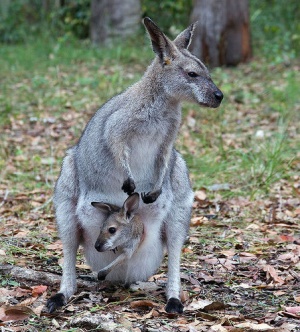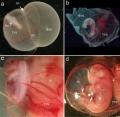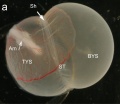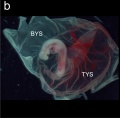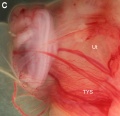Kangaroo Development
| Embryology - 16 Apr 2024 |
|---|
| Google Translate - select your language from the list shown below (this will open a new external page) |
|
العربية | català | 中文 | 中國傳統的 | français | Deutsche | עִברִית | हिंदी | bahasa Indonesia | italiano | 日本語 | 한국어 | မြန်မာ | Pilipino | Polskie | português | ਪੰਜਾਬੀ ਦੇ | Română | русский | Español | Swahili | Svensk | ไทย | Türkçe | اردو | ייִדיש | Tiếng Việt These external translations are automated and may not be accurate. (More? About Translations) |
Introduction
Macropodid marsupial have short five digit forelimbs and large four digit hindlimbs specially adapted for hopping. The hindlimb digits differ from mammals by a missing digit 1, fused digits 2 and 3 and an elongated digit 4.
- tammar wallaby (Macropus eugenii)
| Australian Animal: echidna | kangaroo | koala | platypus | possum | Category:Echidna | Category:Kangaroo | Category:Koala | Category:Platypus | Category:Possum | Category:Marsupial | Category:Monotreme | Development Timetable | K12 | |||||
|
| ||||
| Animal Development: axolotl | bat | cat | chicken | cow | dog | dolphin | echidna | fly | frog | goat | grasshopper | guinea pig | hamster | horse | kangaroo | koala | lizard | medaka | mouse | opossum | pig | platypus | rabbit | rat | salamander | sea squirt | sea urchin | sheep | worm | zebrafish | life cycles | development timetable | development models | K12 |
Some Recent Findings
|
Taxon
Taxonomy ID: 9322
Genbank common name: kangaroo
Inherited blast name: marsupials
Rank: species
Genetic code: Translation table 1 (Standard)
Mitochondrial genetic code: Translation table 2 (Vertebrate Mitochondrial)
Lineage ( full )
cellular organisms; Eukaryota; Opisthokonta; Metazoa; Eumetazoa; Bilateria; Coelomata; Deuterostomia; Chordata; Craniata; Vertebrata; Gnathostomata; Teleostomi; Euteleostomi; Sarcopterygii; Tetrapoda; Amniota; Mammalia; Theria; Metatheria; Diprotodontia; Macropodidae; Macropus
- Links: Taxonomy Browser Macropus
Development Overview
- short pregnancy period (tammar wallaby 26.5 days)
- pregnancy can be maternally delayed (diapause) at blastocyst stage
- born in altricial (underdeveloped) state
- development continues attached to a teat in the pouch
- during pouch period growth controlled by milk composition changes
- immune system, thyroid and thermoregulation develops after birth
Tammar Wallaby
The following images are from a recent paper on placental evolution.[3]
Tammar Wallaby Limb Development[4]
The development of tammar fetal limbs at selected stages before birth. (A) day 19, (B) day 20, (C) day 22, (D) day 24 and (E) day 25 (one day before birth).
- Tammar Limbs: day 19-25 | day 19 | day 20 | day 22 | day 24 | day 25 | Limb Development | Kangaroo Development
Genome
The tammar wallaby karyotype (2 n = 16) consists of 7 autosomes and the two sex chromosomes.[5]
Gonad Development
The following data is from the tammar wallaby (Macropus eugenii) study.[6]
Female ovary
- migrate caudally between days 10 and 20 after birth.
- gubernaculum differentiates into:
- round ligament in the abdomen
- extra-abdominally as the ilio-marsupialis muscle of the mammary glands.
Male testis
- migrate to the internal inguinal ring by day 20 post partum (pp).
- migrate then to the scrotum between days 20 and 65 pp.
- cremaster muscle development begins day 10 pp and structure completed by day 60 pp.
- inguinal canal closed between days 50 and 60 pp.
Rock-Wallaby

Rock-wallaby Australian taxa distribution[7] |
Taxa are colored in accordance with their chromosomal groupings:
|
Mitochondrial coding genes - 12 genes, 11,373 bp.
References
- ↑ <pubmed>22132805 </pubmed>
- ↑ <pubmed>21854559</pubmed>Genome Biol.
- ↑ <pubmed>21854600</pubmed>| PMC3170617 | Evodevo.
- ↑ <pubmed>22235805</pubmed>| BMC Dev Biol.
- ↑ <pubmed>17822525</pubmed>| BMC Evol Biol.
- ↑ <pubmed>12363275</pubmed>
- ↑ Potter S, Bragg JG, Blom MPK, Deakin JE, Kirkpatrick M, Eldridge MDB and Moritz C (2017) Chromosomal Speciation in the Genomics Era: Disentangling Phylogenetic Evolution of Rock-wallabies. Front. Genet. 8:10. doi: 10.3389/fgene.2017.00010
Reviews
<pubmed>18805821</pubmed>
Articles
<pubmed>21672208</pubmed> <pubmed>21540568</pubmed> <pubmed>18431054</pubmed> <pubmed>18322362</pubmed> <pubmed>18069991</pubmed> <pubmed>12220120</pubmed> <pubmed>4791592</pubmed>
Books
- Life of Marsupials by Hugh Tyndale-Biscoe Publisher: CSIRO Publishing (2005).
- Kangaroo - A Portrait of an Extraordinary Marsupial by Stephen Jackson and Karl Vernes Publisher: Allen & Unwin (2010).
Search PubMed
Search PubMed: Kangaroo development | Macropus eugenii | marsupial development
External Links
External Links Notice - The dynamic nature of the internet may mean that some of these listed links may no longer function. If the link no longer works search the web with the link text or name. Links to any external commercial sites are provided for information purposes only and should never be considered an endorsement. UNSW Embryology is provided as an educational resource with no clinical information or commercial affiliation.
- NSW Government Information
- Newborn Baby Grey Kangaroo - Attenborough - Life of Mammals - BBC video
- Birth of the Red Kangaroo (1965) - CSIRO video 1 | video 2 video 3
- NHMRC A guide to the use of Australian native mammals in Biomedical research (1990) - PDF
Glossary Links
- Glossary: A | B | C | D | E | F | G | H | I | J | K | L | M | N | O | P | Q | R | S | T | U | V | W | X | Y | Z | Numbers | Symbols | Term Link
Cite this page: Hill, M.A. (2024, April 16) Embryology Kangaroo Development. Retrieved from https://embryology.med.unsw.edu.au/embryology/index.php/Kangaroo_Development
- © Dr Mark Hill 2024, UNSW Embryology ISBN: 978 0 7334 2609 4 - UNSW CRICOS Provider Code No. 00098G
